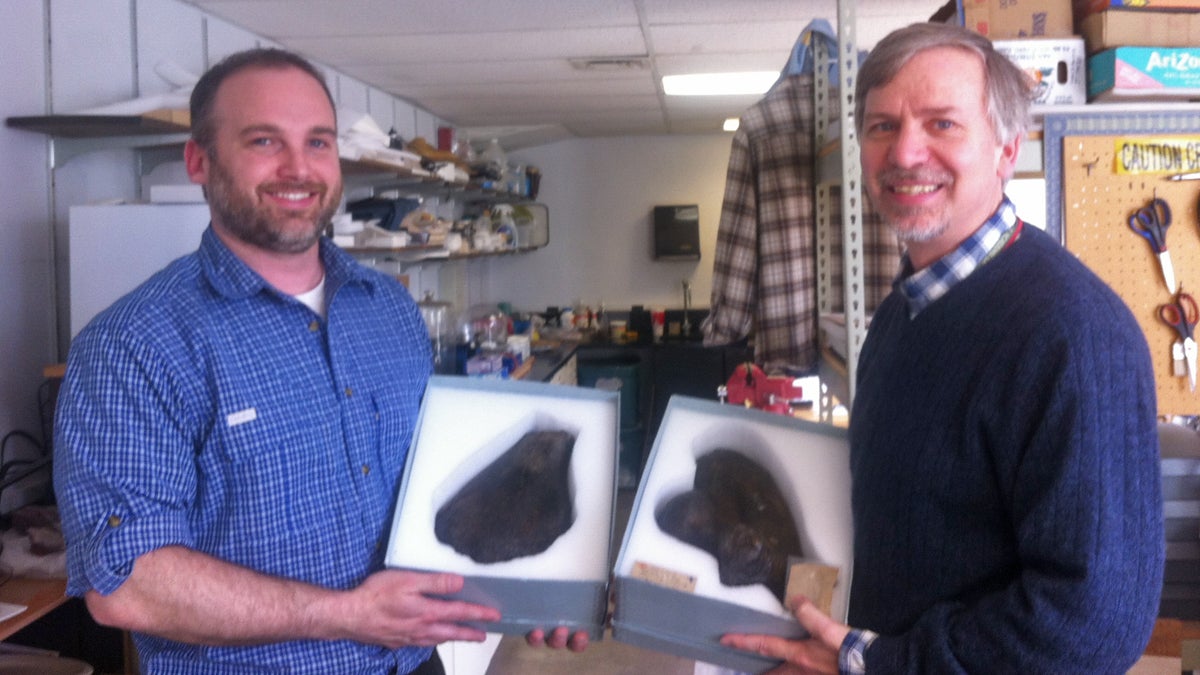‘Once in a lifetime’ chance brings ancient turtle bones back together in Philly

Jason Schein, assistant curator of natural history at New Jersey State Museum (left), and Ted Daeschler, curator of paleontology at the Academy of Natural Sciences of Drexel University, hold two matching pieces of turtle bone. (Maiken Scott/WHYY)
Two pieces of an ancient puzzle have been reunited in Philadelphia, stunning a group of seasoned paleontologists. They just published a research paper on a find they call “once in a lifetime.”
Puzzle piece No. 1 looks a bit like a club.
“In my hands is the bone, which is probably about 14 inches long, with a big head on it that would fit into the shoulder socket of the animal,” said Ted Daeschler, curator of paleontology at the Academy of Natural Sciences of Drexel University.
The piece of bone he described was part of the upper arm of a giant sea turtle, which lived about 75 million years ago. Swiss-born naturalist Louis Agassiz wrote about the bone fragment in 1849, after seeing it in the academy’s collection. But Daeschler says the museum never knew exactly when or where the piece was found.
“The only data that was with this specimen was ‘cretaceous of New Jersey,'” he said.
So, all that was known was that this bone had been at the Academy at least since 1849.
Fast forward to 2012
Digging in creek beds in Central New Jersey, hobby paleontologist Gregory Harpel found a piece of bone, which he brought to the New Jersey State Museum.
Curator David Parris said he thought the bone looks like it could match another piece of bone he had seen many years before in Philadelphia.
Paleontologist Jason Schein was at the state museum that day. “The rest of us laughed when he said said that and thought, ‘haha, that’s hilarious,'” recalled Schein.
A few weeks later, Schein, who was headed to Philadelphia anyway, brought along the piece of bone. At the academy, he lined it up with the Philadelphia bone, and, to everybody’s surprise, saw a perfect fit.
“We just sat there for a couple of seconds, in silence, taking this in,” said Schein. “This is impossible, this can’t be happening.”
Daeschler said there is no doubt that these two pieces make a whole.
“It’s not only that the broken surfaces fit one another, but the anatomy of the bone, the shape, every bit of it is consistent across,” he said. “There is even gnaw marks from a shark on one end that you get on the other end of it as well.”
It’s the only bone of this species that has ever been found, said Daeschler and Schein. Based on having the whole arm bone, they now estimate that the animal was 10 feet long. Each museum will keep its original piece of the bone, but have a replica of the other half to complete the picture.
WHYY is your source for fact-based, in-depth journalism and information. As a nonprofit organization, we rely on financial support from readers like you. Please give today.


